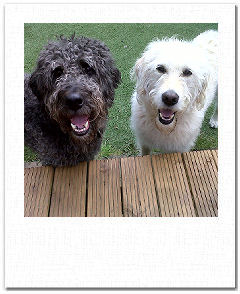 We love our job. Meeting and spending
time with dozens of different dogs of all types and sizes is a great way to earn a living.
We love our job. Meeting and spending
time with dozens of different dogs of all types and sizes is a great way to earn a living.
Having a dog in your family is a
fantastic experience that research shows is good for you, so it is a
privilege for us to be able to help busy families share their lives with a
dog. We make sure their dogs get the care they need when family
members are working, or when older people can no longer give
a dog the exercise they need.
So it's no surprise that dog walkers
are busy.
But how do you choose a dog walker when
so many people offer dog-walking services?
We are not the only dog walkers in our
area and often recommend others when we are too busy to take on new
dogs, so what standards do we insist on, and what should you look for
when choosing someone to come into your home to care for your pet?
This seems like a no-brainer but is
easily overlooked when someone seems 'nice'. Someone who is going to
probably have a key to your house and be responsible for your dog
(that may have cost many hundreds of pounds) should be police-checked
to make sure they have a trustworthy background and should be happy
to provide references from other customers that you can check.
Trust Your Dog Walker
Reputation is a good guide, so ask
around your local area – in the vets or local pet shops who they
recommend.
Is Your Dog Walker Insured?
Your dog walker should have third party
liability insurance as a minimum, and should be happy to discuss the
cover provided. How will your dog be transported? Is the vehicle fit
to carry animals and is it insured specifically for that purpose as a
business?
Knowledge and Expertise
What experience and knowledge does your
dog walker have? They don't have to be dog trainers or behavioural
experts but they certainly should be experienced handlers of a wide
range of types of dog.
If they are interested in dogs they
will probably also be able to tell you about loads of other
interesting courses or workshops they have attended too – for
example they may be involved in training clubs, or breed clubs with
their own dogs, or have done animal first aid training for example.
A Professional Dog Walker
 Your dog walker should want to record a
wide range of information about you and your dog to make sure they
are equipped with enough information to look after your dog for you,
including emergency contacts and vets.
Your dog walker should want to record a
wide range of information about you and your dog to make sure they
are equipped with enough information to look after your dog for you,
including emergency contacts and vets. They should also been in regular contact with you with updates about your dog's behaviour, health, socialisation to help you care for your dog.
The National Association of RegisteredPet Sitters is a membership organisation with a code of practice.
Membership is voluntary but is a good guide to the standards and
professionalism of your dog walker.
We are proud to be members and agree to their code of practice and are happy to answer any questions about the service we offer, or about us or our own lovely dogs. You can find out more about us at www.animalassistance.co.uk




